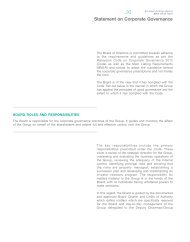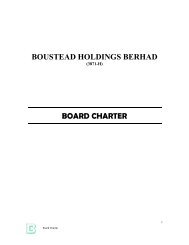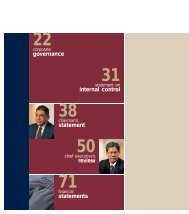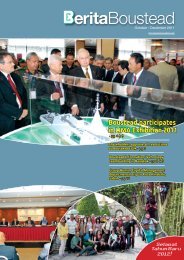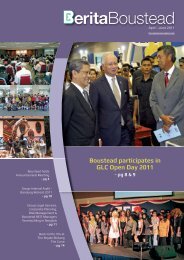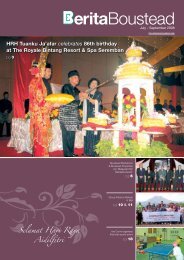Directors - Boustead Holdings Berhad
Directors - Boustead Holdings Berhad
Directors - Boustead Holdings Berhad
Create successful ePaper yourself
Turn your PDF publications into a flip-book with our unique Google optimized e-Paper software.
Accounting Policies<br />
(c) ASSOCIATES<br />
80<br />
An Associate is defined as a company, not being a Subsidiary or an interest in a joint venture, in which<br />
the Group has a long term equity interest of not less than 20% and in whose financial and operating<br />
decisions the Group exercises significant influence. Significant influence is the power to participate in the<br />
financial and operating policy decisions of the investee but not in control or joint control over those<br />
policies. Details of Associates are given on page 143.<br />
Investments in Associates are accounted for in the consolidated financial statements using the equity<br />
method of accounting. Under the equity method, the investment in an Associate is carried in the<br />
consolidated balance sheet at cost plus post acquisition changes in the Group’s share of net assets of<br />
the Associate, less distributions received and less any impairment in value of individual investments. The<br />
consolidated income statement reflects the Group’s share of the Associate’s results after tax. Where there<br />
has been a change recognised directly in the equity of an Associate, the Group recognises its share of<br />
such changes. Unrealised gains or losses on transactions between the Group and its Associates are<br />
eliminated to the extent of the Group’s interest in the Associates. When the Group’s share of losses<br />
exceeds its interest in an Associate, the Group does not recognise further losses except to the extent<br />
that the Group has incurred legal or constructive obligations or made payments on behalf of the<br />
Associate.<br />
After application of the equity method, the Group determines whether it is necessary to recognise any<br />
additional impairment loss with respect to the Group’s net investment in an Associate. Associates are<br />
equity accounted from the date the Group obtains significant influence until the date the Group ceases<br />
to have significant influence.<br />
Any goodwill arising on the acquisition of an Associate, representing the excess of the cost of the<br />
investment compared to the Group’s share of the net fair value of the Associate’s identifiable assets,<br />
liabilities and contingent liabilities, is included in the carrying amount of the Associate and is not<br />
amortised. To the extent that the net fair value of the Associate’s identifiable assets, liabilities and<br />
contingent liabilities is greater than the cost of the investment, a gain is recognised and added to the<br />
Group’s share of the Associate’s profit or loss in the period in which the investment is acquired.<br />
The most recent available financial statements of Associates are used by the Group in applying the<br />
equity method. Where the dates of the audited financial statements used are not coterminous with those<br />
of the Group, the share of results is arrived at from the last audited financial statements available and<br />
management financial statements to the end of the accounting period. Where necessary, adjustments are<br />
made to bring the accounting policies used into line with those of the Group.<br />
(d) INVESTMENTS IN SUBSIDIARIES AND ASSOCIATES<br />
In the Company’s separate financial statements, investments in Subsidiaries and Associates are stated<br />
at cost less impairment losses, if any. On disposal of such investments, the difference between net<br />
disposal proceeds and their carrying amounts is charged or credited to profit or loss.



